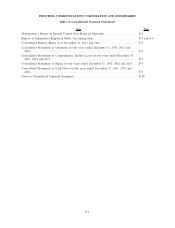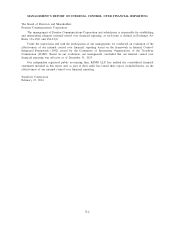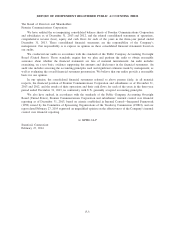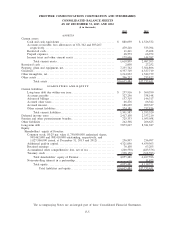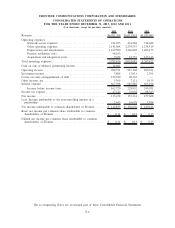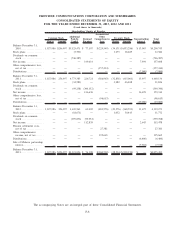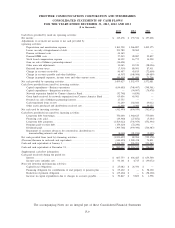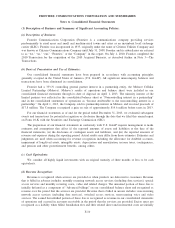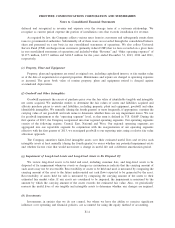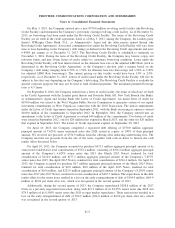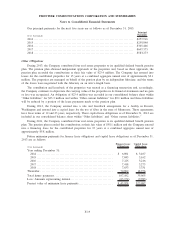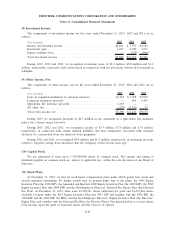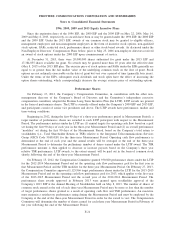Frontier Communications 2013 Annual Report Download - page 73
Download and view the complete annual report
Please find page 73 of the 2013 Frontier Communications annual report below. You can navigate through the pages in the report by either clicking on the pages listed below, or by using the keyword search tool below to find specific information within the annual report.deferred and recognized as revenue and expense over the average term of a customer relationship. We
recognize as current period expense the portion of installation costs that exceeds installation fee revenue.
As required by law, the Company collects various taxes from its customers and subsequently remits these
taxes to governmental authorities. Substantially all of these taxes are recorded through the consolidated balance
sheet and presented on a net basis in our consolidated statements of operations. We also collect Universal
Service Fund (USF) surcharges from customers (primarily federal USF) that we have recorded on a gross basis
in our consolidated statements of operations and included within “Revenue” and “Other operating expenses” of
$117.5 million, $119.7 million and $104.5 million for the years ended December 31, 2013, 2012 and 2011,
respectively.
(e) Property, Plant and Equipment:
Property, plant and equipment are stated at original cost, including capitalized interest, or fair market value
as of the date of acquisition for acquired properties. Maintenance and repairs are charged to operating expenses
as incurred. The gross book value of routine property, plant and equipment retired is charged against
accumulated depreciation.
(f) Goodwill and Other Intangibles:
Goodwill represents the excess of purchase price over the fair value of identifiable tangible and intangible
net assets acquired. We undertake studies to determine the fair values of assets and liabilities acquired and
allocate purchase prices to assets and liabilities, including property, plant and equipment, goodwill and other
identifiable intangibles. We annually (during the fourth quarter) or more frequently, if appropriate, examine the
carrying value of our goodwill and trade name to determine whether there are any impairment losses. We test
for goodwill impairment at the “operating segment” level, as that term is defined in U.S. GAAP. During the
first quarter of 2013, the Company reorganized into four regional operating segments. Our operating segments
consist of the following regions: Central, East, National and West. Our regional operating segments are
aggregated into one reportable segment. In conjunction with the reorganization of our operating segments
effective with the first quarter of 2013, we reassigned goodwill to our reporting units using a relative fair value
allocation approach.
The Company amortizes finite-lived intangible assets over their estimated useful lives and reviews such
intangible assets at least annually (during the fourth quarter) to assess whether any potential impairment exists
and whether factors exist that would necessitate a change in useful life and a different amortization period.
(g) Impairment of Long-Lived Assets and Long-Lived Assets to Be Disposed Of:
We review long-lived assets to be held and used, including customer lists, and long-lived assets to be
disposed of for impairment whenever events or changes in circumstances indicate that the carrying amount of
such assets may not be recoverable. Recoverability of assets to be held and used is measured by comparing the
carrying amount of the asset to the future undiscounted net cash flows expected to be generated by the asset.
Recoverability of assets held for sale is measured by comparing the carrying amount of the assets to their
estimated fair market value. If any assets are considered to be impaired, the impairment is measured by the
amount by which the carrying amount of the assets exceeds the estimated fair value. Also, we periodically
reassess the useful lives of our tangible and intangible assets to determine whether any changes are required.
(h) Investments:
Investments in entities that we do not control, but where we have the ability to exercise significant
influence over operating and financial policies, are accounted for using the equity method of accounting.
F-11
FRONTIER COMMUNICATIONS CORPORATION AND SUBSIDIARIES
Notes to Consolidated Financial Statements


